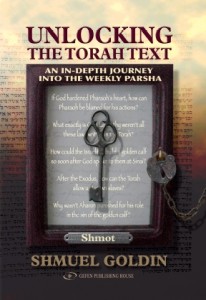Excerpted from Rabbi Shmuel Goldin’s Unlocking the Torah Text-Shmot: An In-Depth Journey into the Weekly Parsha, co-published by OU Press and Gefen Publishers
 A Retrospective: Putting Sinai in Perspective
A Retrospective: Putting Sinai in Perspective
Context
One of the indelible images of the book of Shmot is of the free-willed acceptance by the Israelites of the Torah at Sinai, captured in the people’s proclamation “we will do and we will hear.” Yet a Midrashic tradition quoted in the Talmud shatters that image, painting a vastly different picture.
Rabbi Avdimi bar Chama bar Chasa maintains that the Torah passage “And [the Israelites] stood at the base of the mountain” implies that during Revelation, “God held the mountain over them like a barrel and proclaimed: ‘If you accept the Torah, fine – but if not, here will be your burial!’ ”
Rava agrees with Rabbi Avdimi but claims that, centuries later, at the time of the Purim story, the Jews finally freely accept what their ancestors had accepted at Sinai under duress. As proof he cites a passage at the end of Megillat Esther which closely parallels the commitment “we will do and we will hear” rooted at Sinai. The Megilla testifies that the Jews “fulfilled and accepted.” “They fulfilled,” says Rava, “that which they had already accepted.”
Questions
Why do the rabbis transform the scene at Sinai so completely? Why is Rabbi Avdimi so intent upon adding an element of coercion to the Revelation narrative that does not seem to exist in the straightforward reading of the text?
Furthermore, how does the Purim story, according to Rava, relate to the Revelation narrative? Purim, a story of survival from the Persian period of Jewish history, occurs centuries later and would seem to be completely unrelated to the events at Sinai. Is Rava simply playing a word game, arbitrarily connecting two totally different tales on the basis of a linguistic nuance?
Approaches
Through a figurative, rather than literal, interpretation of this well-known Midrash, a powerfully significant lesson can be derived.
A
The rabbis demonstrate tremendous historical integrity as they ask us to put ourselves in the place of the Israelites at Sinai: You have just witnessed the Ten Plagues, the Exodus, the parting of the Reed Sea, the battle with Amalek, the gift of the manna and more. And now, amidst the thunder, lightning and sounding of the shofar of Revelation, God turns to you and asks, “Will you accept my law?”
Could your answer possibly be anything other than a resounding “Yes”?
On a technical level, of course the Israelites retained their free will during Revelation. In reality, however, they were faced with coercion of circumstance. It was as if “God held the mountain over their heads.” Given the surrounding environment, they did not have the opportunity to freely choose.
B
In this light, Rava’s puzzling observation suddenly makes abundant sense, as well.
Yes, he says, it is true that at Sinai the Israelites did not have the benefit of choice. Surrounded by the miraculous events of the moment, they could not choose a different path.
The time comes, however, when God withdraws; when His hand in the world is no longer open and He orchestrates events from behind a screen. Within the national era of Jewish history, that moment arrives at the time of the Purim tale. Purim marks the onset of the non-prophetic period of the national era. At no point does God speak directly to Esther or Mordechai, the heroes of the story. They must, instead, determine divine will during a time of God’s silence and in the face of extraordinarily trying circumstances.
And when the Jewish community of that day accepts the story of Purim as divinely orchestrated, when they see the hidden miracle in a series of events that could have been interpreted as coincidental – only then, for the first time, the nation accepts with total freedom what their ancestors were forced to accept at Sinai.
As we have noted before, both the patriarchal era and the national era of Jewish history open with clear, direct communication between God and man. A point is reached, however, in each of these eras, when prophecy is silenced and God pulls back to allow us to find our own way. Just as a parent must let go of the child’s hand if a child is to learn to walk on his own, so too God withdraws and challenges us to determine our path.
And when that moment arrives – during the patriarchal era at the time of the Yosef story, and during the national era at the time of Purim (see Bereishit: Vayeishev 1) – full free will is born and our challenge truly begins.
Points to Ponder
One of the common questions asked by children and adults alike as we consider the flow of Jewish history is, “Why did God limit the performance of miracles to ancient times?” With a sense of longing, we look back to a time when everything was open, when God’s existence was obvious and His connection to our lives clear.
The rabbis, however, would have us understand that, on some level, this sense of longing is misplaced.
To live in a time when God is “hidden” is to face a trial that transcends the test of Sinai. When the thunder, lightning and shofar of the book of Shmot fall silent; when we are forced to find and appreciate God’s existence in the quiet miracles that surround us each day, that is when the mature challenge truly begins.

